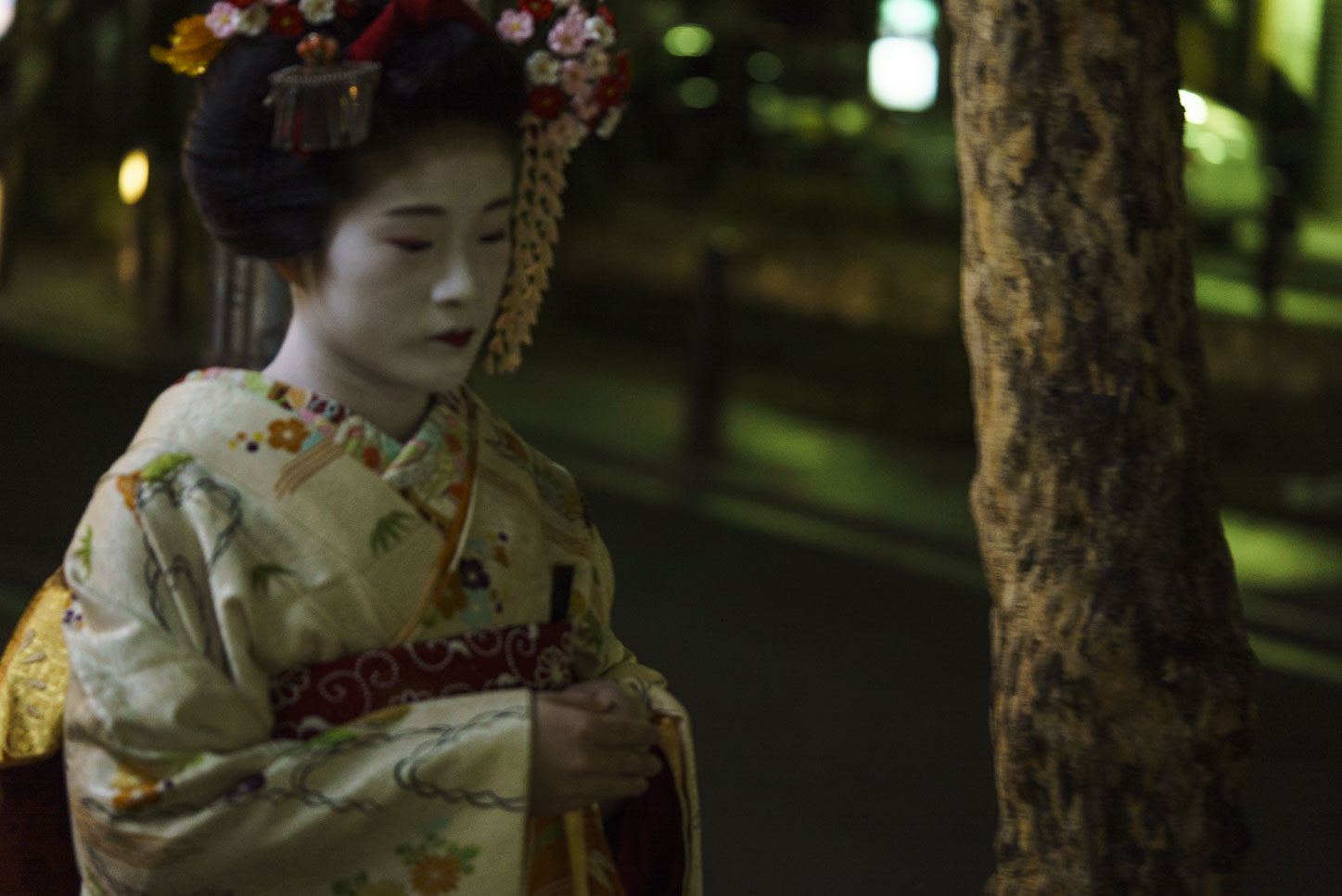THE MASTER OF CRAFT
THE EXPRESSIVE KIMONO
KYOTO, JAPAN
Scroll to explore
The Story
A CONVERSATION WITH EN ISOMOTO
KIMONO PRODUCER IN KYOTO, JAPAN
En Isomoto manages production for Chiso, a Kyoto-based, Yuzen-dyeing fabric and kimono house founded in 1555. His role is to ensure the continuation of the invaluable artistry of traditional dyeing techniques, including the hand-crafted, bespoke silk kimono masterpieces that his team of designers, draftsmen and craftsmen specialists create over a period of four weeks to eighteen months, depending on the intricacies of the design.
There are
EN ISOMOTO, KIMONO PRODUCER
so many stories, hopes
and dreams embedded in
the cloth.

S+O — HOW DID YOU BEGIN YOUR CAREER AT CHISO?
Isomoto — I was born in Kyoto. My father was a customary Japanese chef, so I have always been drawn to our traditions and what we call “wa” [a cultural concept considered integral to the Japanese society]. I started working at Chiso as a student interested in our traditions, and have now been here for twenty-five years learning about all aspects of this business. My job is not just about dyeing cloth, but also sustaining the culture.
S+O — WHAT IS THE HISTORY OF CHISO?
Isomoto — About four hundred and sixty-two years ago, in 1555, Chiso was founded here in Kyoto. The company specialized in making temple garments until the Edo period ended and the Meiji era began. After the Meiji era began, there was a great number of cultural revolutions, including the loss in influence of the temples along with the transfer of the capital from Kyoto to Tokyo. Up until this point, kimonos like this were only worn by the aristocrats [Kuge] and elite, but the cultural shifts along with an increasing westernization opened the doors for people from all sorts of backgrounds, being able to wear these types of kimonos.
S+O — WHAT MATERIALS WERE USED TO CREATE THE KIMONOS WORN BY THE KUGE?
Isomoto — Originally the Kuge wore tapestries that were woven with gold threading and embroidery, or shibori dye. These were the techniques applied to old fashioned kimonos before the laws came into effect banning any displays of wealth.


S+O — HOW DID THE YUZEN DYEING TECHNIQUE EVOLVE?
Isomoto — Yuzen dyeing comes from a person named Miyazaki Yuzen who, as an original designer, developed a technique called “Tata-dyed Yuzen” during the end of the seventeenth century. During this period, when the extravagant displays of wealth were banned, the colorful Yuzen designs could be produced using his paste resist-dyeing techniques, and creating beautiful depictions which were applied to the kimonos that could get around the ban. Fashion was still enjoyable, and I think that was the major reason this became popular.
S+O — HOW IMPORTANT IS YUZEN DYEING TO KIMONO MAKING?
Isomoto — There are roughly twenty steps to making a kimono, and about ten of those steps will involve Yuzen dyeing. It’s all about the colors. You can truly start to appreciate the colors that nature provides, when you see them applied to a kimono. I think, personally, that's a very important part of kimono designing that I truly admire.
S+O — HOW DOES KYOTO’S WATER SUPPLY IMPACT THE QUALITY OF THE DYE?
Isomoto — Water is quite valuable to the process. Depending on the balance of minerals, some colors appear to be more transparent, or more opaque. For instance, if you dyed a piece of cloth in Tokyo and one in Kyoto using the same pigments, the colors would be completely different. The water would affect the saturation, and sometimes even the color itself. At some point it was decided that the water in Kyoto is much more suited for dyeing. Especially, the softer, more pastel colors seem to come out nicely here. They say that is why the dyeing culture developed here versus other places.


S+O — WHAT TYPE OF SCENES OR MOTIFS ARE USUALLY DEPICTED ON THE DESIGNS?
Isomoto — Sometimes the kimono designs are really jam-packed with meaning. There are so many stories, hopes, and dreams embedded in the cloth. These can be stories about lovers, or a relationship between a parent and a child, or more abstract ideas of “ultimate happiness”. I think an expression of happiness, or symbolic gestures are most commonly depicted on kimonos. There are a lot of emotions, not only for the client. I think that kimonos also carry the emotions of the craftsmen.

Kimonos
also carry the
emotions of the
craftsmen.
S+O — HOW DO YOU SOURCE INSPIRATION FOR THE DESIGNS?
Isomoto — Record-keeping is important to the legacy of traditional, Japanese garments. We’ll often come up with a theme, and a concept that matches the occasion or message, and then research options from our archives. Of course there are completely new designs, but we try to study these older designs, and incorporate them into designs for modern living. To me, this is a very important aspect in our kimono-making.


S+O — DESCRIBE THE EXPERIENCE OF WEARING A KIMONO?
Isomoto — I believe you can learn a lot about kimonos just by looking at, and studying them. However, you really need to wear one to fully enjoy the experience. To put your arms through the sleeves, and wrap your body in a kimono— this is truly the best way to understand it. Then it’s about the design. You begin to understand a person by the design they choose to wear. There’s so much information in how it is worn. It's really important for people to understand, regardless of being a Japanese person or someone from somewhere else, that kimonos are meant to be enjoyed and their beauty understood as well.
S+O — WHY DO PEOPLE WEAR KIMONOS TODAY?
Isomoto —There is an old proverb that says “Ishokujyu”, which literally means clothing, food, and shelter. The Japanese really value Ishokujyu. Kimonos fulfill the “personal identity" need [clothing], but they are also able to portray certain kinds of emotions, like the familial relationship that I’ve mentioned. Nowadays, kimonos are reserved for the most special occasions. In January, we have Seijin-shiki, which is a celebration for the advent into adulthood at the age of twenty. This is potentially the biggest occasion that people still have kimonos made nowadays. Otherwise, there are people who wear them to weddings or formal parties. And of course, traditional arts such as tea ceremonies or flower arrangements, still include kimonos.
S+O — WHAT COMPELS YOU TO STAY IN THIS BUSINESS?
Isomoto — Although I have been working in the industry for several years, there is still an unbelievable amount of information about this world that I do not know yet. I learn something new every single day. Whether it is something about design, materials, or even the people that we are creating kimonos for, something new is introduced to me constantly. I think that is really wonderful. This is one of our greatest traditions. I think it is important for Kyoto and all of the Japanese culture in general. I think that in the future we'll really have to reexamine our culture, and will still preserve the kimono. It is part of our duty, and that's why this work is important.


Kimonos are
meant to be enjoyed,
and their beauty understood
as well.
Credits
Photography by Brian Sokol
Film by Oresti Tsonopoulos and Alexandra Stewart
Special Acknowledgments - Shinichi Kinoshita and Ayako Mochimaru of Fixers Japan
The Objects
Exclusive Edition 011 Japanese Silk Kimono
Silk kimonos are deeply connected to the rich cultural history of Japan. The variations of styling are nearly innumerable with designs based on personal stories, natural landscapes, Japanese gods and lucky motifs. A kimono is typically constructed in nearly twenty steps which include the finest silk cloth as a canvas for the artistic creations that are carefully brush-dyed by masters employing the ancient Yuzen technique. Golden embroidery can also be delicately applied in 24 or 18 carat gold to further heighten the luxurious finish of these wearable works of art.
The Destination
KYOTO, JAPAN
Kyoto was the Imperial capital of Japan for over a thousand years, which left an indelible imprint on the city’s charm and old world sophistication. Here, tradition harmoniously balances with modernity. A manicured state of nature melds into urbanity. Rich in meticulously preserved history, this is where one truly begins to understand the roots of Japanese culture.



